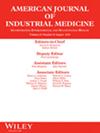Impact of Extreme Bushfires on Occupational Injury and Disease Claims in the Nonemergency Response Labor Force
Abstract
Background
Extreme bushfires pose significant occupational health risks; however, research has primarily focused on emergency responders without investigating the effects on the broader labor force. This study examined the association between extreme bushfire periods and workers' compensation claims in the nonemergency response workforce.
Methods
Workers' compensation claims from the labor force (excluding first responders) were obtained from WorkSafe Victoria for the period January 2005 through April 2023. Claims for injury or disease with recorded onset dates that occurred during extreme bushfires in Victoria, Australia (Black Saturday 2009; Black Summer 2019–2020) were compared with claims in other periods using logistic regression, adjusting for sociodemographic, injury/disease, occupational, and seasonality variables.
Results
Of 78,057 claims, 1646 (2.1%) had injury/disease onset dates within extreme bushfire periods. Extreme bushfire period claims were associated with workers aged 25–34 years (odds ratio [OR] = 1.21, 95% confidence interval [CI] = 1.04–1.42) and ≥ 55 years (OR = 1.30, 95% CI = 1.12–1.51) compared to those aged 35–44 years. Claims for respiratory conditions (OR = 3.81, 95% CI = 2.58–5.62) and fractures (OR = 1.31, 95% CI = 1.09–1.56) were associated with extreme bushfire periods. Claims from workers in construction (OR = 1.25, 95% CI = 1.03–1.51), accommodation and food services (OR = 1.53, 95% CI = 1.18–1.99), education and training (OR = 1.34, 95% CI = 1.07–1.67), and financial services (OR = 2.01, 95% CI = 1.35–3.00) industries, relative to manufacturing industry claims, were associated with extreme bushfire periods.
Conclusion
During extreme bushfire events, patterns of workers' compensation claims changed somewhat among the nonemergency response labor force. Although these were relatively small numbers of events, this study provided some evidence to suggest that events like bushfires, predicted to become more common, could have wider occupational consequences, highlighting the need for prevention and mitigation strategies.

 求助内容:
求助内容: 应助结果提醒方式:
应助结果提醒方式:


